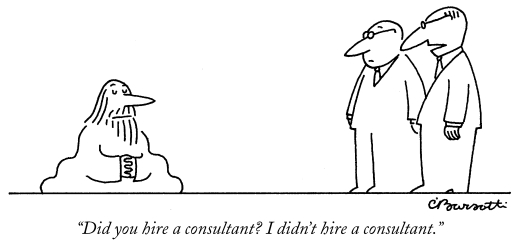Untapped

Folks might ask: why is the consultant here? There are people on the inside who can do it just as good, if not better, but for whatever reason, are not being asked to do so, are going untapped.
A consultant might work for us in various roles:
- Responsible Contributor – extra pairs of hands, more human resource to complement our efforts, responsible for specific deliverables under our management.
- Responsible Leader – someone to orchestrate, manage, lead; an adult who can manage up and down, and sideways, navigate through an event, a project, a program, or one of the other many flavors of initiative we’ve got going.
- Expert, Subject Matter Specialist – a domain master, specialist in some aspect of technology or architecture or market or channel or industry
And while the extra hands, personality, and mind, of the 3rd party you’ve brought in, might indeed be an asset, know that there might be some of the Untapped who are potentially seeing it a bit differently.
An extra pair of hands can clutter the workbench and cutting boards of proud craftsmen and master chefs. An extra personality can upstage both aspiring and accomplished thespians. And who needs more than our 1 resident guru?
Keep your team tapped. Manage your talent. Grow from within by regularly immersing your people in the outside. Be candid in why you’ve had to bring in a 3rd party. Be sensitive to the reasons why you’ve had to do so; these are clues to where you might be lacking in your own capabilities to manage, grow, and empower internal talent.
This New Yorker cartoon is paid for and used under Non-Exclusive license agreement with Condé Nast.
Cartoonist: Charles Barsotti, The New Yorker Collection
© Michael C. Simonelli, onthegocio.com, 2013
The Soundtrack

Wake up, sing in the shower, exit your flat, whistle a tune, commute, i-Play a favorite ditty, Zumba to beats, 150+ per minute, dine to ballads, promenade to hip-hop, talk over soft jazz, shop to Pop, fall asleep to pink noise. Music and sound everywhere.
Now consider your workplace and its soundtrack, the themes motivating the dancers on your projects, programs, and change initiatives. A lonesome horn, over some bass and swirling brushwork? A blend of finely tuned multi-part harmonies? 12-tone and dissonant or easy to hum? The usual verse-chorus-verse-chorus-fade, or something more?
Satie’s Trois Gymnopédies. Miles’s Blue in Green. SOS Band’s Take Your Time. Sinatra’s Come Fly With Me. Segovia’s Bach Prelude. St. Vincents Party. Your favorite?
They’re all playing out there, in your head, in the office next-door, on the floor below, down the boulevard, across the country, after the sun, the different tunes, the backbones laid down by the different drummers.
To each their own. Include your favorites and then play them all. Not one at a time, but all at once. You will potentially need to, dear Maestro, to bring order to what would otherwise be cacophony.
© Michael C. Simonelli, onthegocio.com, 2013
What do Margaret Mead and Hunter S. Thompson have in common?

2 quotes to get you thinking about organizational change.
The first from Margaret Mead, an anthropologist known for her work in helping us to consider cultural evolution: “Never believe that a few caring people can’t change the world.”
Mead believes that transformation results from a cluster of interacting people who make choices and set direction, responsible for crucial innovations, disrupting relationships with other groups, funneling events until change occurs.
In Continuities in Cultural Evolution, Mead writes: “Even in the very simplest culture we find conditions which are favorable or unfavorable to evolution in the ways in which age, sex, and the manipulation of even very small amounts of esoteric knowledge are structured, so that the specially gifted are assured-or deprived-of a chance to exercise their gifts in any particular field.”
I think Mead’s ideas neatly complement the sentiment of our second quote, from Hunter S. Thompson, American writer and founder of Gonzo journalism: “When the going gets weird, the weird turn pro.”
In upcoming posts we explore the potential for Communities of Professionals as disruptive clusters and their members as catalysts for change.
© Michael C. Simonelli, onthegocio.com, 2013
